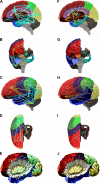Neuronal connectivity in major depressive disorder: a systematic review
- PMID: 30425491
- PMCID: PMC6200438
- DOI: 10.2147/NDT.S170989
Neuronal connectivity in major depressive disorder: a systematic review
Abstract
Background: The causes of major depressive disorder (MDD), as one of the most common psychiatric disorders, still remain unclear. Neuroimaging has substantially contributed to understanding the putative neuronal mechanisms underlying depressed mood and motivational as well as cognitive impairments in depressed individuals. In particular, analyses addressing changes in interregional connectivity seem to be a promising approach to capture the effects of MDD at a systems level. However, a plethora of different, sometimes contradicting results have been published so far, making general conclusions difficult. Here we provide a systematic overview about connectivity studies published in the field over the last decade considering different methodological as well as clinical issues.
Methods: A systematic review was conducted extracting neuronal connectivity results from studies published between 2002 and 2015. The findings were summarized in tables and were graphically visualized.
Results: The review supports and summarizes the notion of an altered frontolimbic mood regulation circuitry in MDD patients, but also stresses the heterogeneity of the findings. The brain regions that are most consistently affected across studies are the orbitomedial prefrontal cortex, anterior cingulate cortex, amygdala, hippocampus, cerebellum and the basal ganglia.
Conclusion: The results on connectivity in MDD are very heterogeneous, partly due to different methods and study designs, but also due to the temporal dynamics of connectivity. While connectivity research is an important step toward a complex systems approach to brain functioning, future research should focus on the dynamics of functional and effective connectivity.
Keywords: EEG; MDD; effective connectivity; fMRI; functional connectivity; major depressive disorder; structural connectivity.
Conflict of interest statement
Disclosure The authors report no conflicts of interest in this work.
Figures





References
-
- Arnold JF, Zwiers MP, Fitzgerald DA, et al. Fronto-limbic microstructure and structural connectivity in remission from major depression. Psychiatry Res. 2012;204(1):40–48. - PubMed
-
- Bear MF, Connors BW, Paradiso MA. Neuroscience: exploring the brain. 2. Baltimore: Lippincott, Williams & Wilkins; 2001.
Publication types
LinkOut - more resources
Full Text Sources

